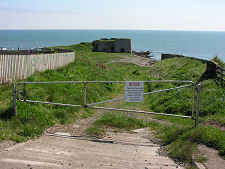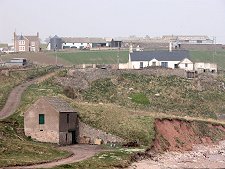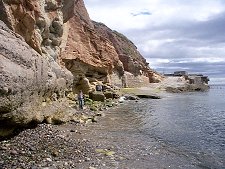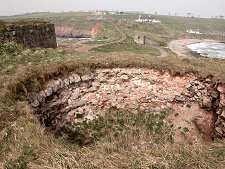Scottish Titbits
Friday, 7 September 2012
It is said that there are more statues of Robert Burns than anyone else in the World.
The contender for the crown is Chairman Mao.
Dalness, nr Glencoe, is the Wettest place in Scotland
Ian Fleming had a home there. According to the Met Office it receives 3.3m of rain per year.
Thursday, 6 September 2012
There are 50 or so "Cursus Monuments" in Scotland. A good example can be found at Cleaven Dyke near Blairgowrie.
NO 162 405. The Cleaven Dyke is a complex earthwork comprising a pair of parallel ditches (c.45m to 51m apart), with a central bank, running NW to SE for 1820m through woodland. A further 350m or so is visible as a cropmark (NO13NE 89) at the SE end. The central bank which is between 1m and 2m high and about 9m broad, appears to consist of conjoined dumps, and the ditch, where visible as a cropmark, appears to be made up of linked segments. Radiocarbon dating of samples from the first (1993) season has shown that the Dyke is a Neolithic monument, dating to before 3600BC (Barclay et al 1995).
A trench was opened immediately to the SE of the cross-section of the bank opened in 1993. It was an axial section along the bank designed to examine one of the apparent boundaries between two dumps. One of the characteristics of the bank is a lateral 'toe' of turf holding the gravel of the bank in place on each side. Richmond (Richmond 1940) demonstrated that at one of the constructed breaks in the bank the 'toeing' continued round the end of the bank segment. The 1995 section also showed that the NW of the two dumps was finished off at its SE end in the same way, the dump to the SE then being added. It seems likely therefore that the bank was constructed in segments.
On the old land surface there were few features. The most interesting was a shallow pit, the contents of which formed a low gravel mound immediately beside it. It is possible that this was one of a series of markers on the line of the bank.
Sponsors: British Academy, Russel trust, Society of Antiquaries of Scotland, Society of Antiquaries of London, Prehistoric Society, Historic Scotland.
G J Barclay and G S Maxwell 1995.
Tuesday, 4 September 2012
The only official Nudist Beach in Scotland is at Cleat's Shore on Arran
From BBC.co.uk:
To bare or not to bare?
| Posted: Tuesday, 10 January 2006 | 7 comments |
Having been discussing the beauty therapy benefits of naturism in the northern climate on Annie Beags’ blog over on the Western Isles I thought it was only fair to warn everyone that Cleats Shore near Kilmory on the west coat of Arran is the only official nudist beach in Scotland as far as I know. Having said that it’s not exactly a wall to wall flesh pot. So Calumannabel, should we start our Nuddy Beach for Lewis Campaign now so the fanksters can top up their blue bits? Give reasons why Lewis deserves it’s own nudist beach here. Perhaps we could have some suggestions regarding which beach would be ideal or maybe reasons against? Here’s part of an article from a well known Scottish newspaper giving some pro’s and cons:
Nudism: is it time to grin and bare it?
Scottish beaches get rave reviews in a new book on naturism. A fully clothed Adrian Turpin investigates
Scotland and nudism — an unlikely mix? You might think so but Nick Mayhew, the author of the naturist guidebook Bare Britain, is out to correct a few misconceptions. “Up until 100 years ago, when people went swimming in Scotland they would have stripped off,” he says. “Look at Rob Roy. Remember Liam Neeson famously swimming in the nude?” It may come as a shock to discover that Rob Roy MacGregor was a proto-naturist, skinny-dipping between skirmishes, sunning himself in the altogether, hands on hips by the banks of Loch Voil. But the rest of what Mayhew, a 36-year-old London-based travel writer, had to say this week was even more surprising. Scotland’s beaches are apparently a naturist’s paradise. “As someone who has written a naturist guide to Europe, I can say that Scotland is the most beautiful place in it,” says Mayhew. “For me, it’s a wilderness thing. It’s nice having your own bit of wilderness.”
There is, in fact, only one official nudist beach in Scotland: Cleat’s Shore, in the south of Arran. “I suspect it’s probably the least visited nudist beach in the known universe,” says Mayhew. The other sites mentioned in the guide — including Glenaladale by Loch Shiel, Glengarrisdale Bay in north Jura and Loch Arienas in Morvern — have been chosen for their mixture of remoteness and beauty but are offered with a warning: “If you do decide to enjoy a spot of unofficial skinny-dipping, do so with care and respect for others. If in doubt, cover up rather than risk offending.”
As for the small matter of the climate: “I was swimming in Sanna Bay near Ardnamurchan Point earlier this month,” says Mayhew. “Not for very long, but some of the word’s most famous bare-bathers are Swedish. Compared to Scotland, that’s a lot colder. In the far north of the country, there’s a naturist beach inside the Arctic Circle. In midsummer, you get 24-hour sunlight.” And has he found an answer to intimate midge bites? “Isn’t that what everyone wants to know? I’ll sell you that for a million quid,” he says.
But as the Bare Britain guide admits: “It’s not only the midges that can make life unbearable for bare bathers.” Naturists may be ready for the west coast, but are the locals ready for naturists? One of the beaches also singled out by Bare Britain is Glasnacardoch on the Ardnish peninsula, locally known as the “singing sands” because of the noise made as you walk over it. Are the locals aware that they are living near a nudist hot (or should that be cold) spot? “I can honestly say I’ve never seen anyone nude round here. It wouldn’t go down very well at all. It’s a place for families,” says Jilly Jones, who runs the Old Library Lodge hotel in Arisaig. Maybe that’s a sign of how discreet they are? “I don’t think there’s an awful lot to hide behind down there to be honest,” says Jones. You’re sure you’re not missing out on a niche market? “I’m not missing out on anything.”
Wouldn’t coachloads of Danes and Germans, not deterred by the weather but eager to be buffed to a high gloss by the Atlantic gales, provide just the shot in the arm which the Highland economy needs? Wouldn’t you be tempted, I ask Jones, if VisitScotland offered to pay for a free advert in Health and Efficiency magazine? “I don’t think so,” she says. “I’d rather people just kept their clothes on. Normally nudists are just old people who tend to let it all hang out.”
The writer and Highland historian John MacLeod, a native of Harris, adds: “It is difficult to think of a nudist invasion without an awful lot of hilarity. The horizontal rain. The icy chill of the Atlantic. Bumpy, wobbly flesh. Unspeakable.” As the son of a minister and an occasional outspoken commentator on public morality, however, MacLeod’s objections go beyond the aesthetic. “The fact is we are meant to be clothed,” he says. “The English language suggests that. ‘Stripped’, ‘naked’, ‘nude’ are all synonyms for diminished. The whole point of clothing is that it’s a social discipline. To put it crudely, it’s there to cover signs of sexual arousal. Men and women, boys and girls, naked together is an affront on many levels. The naturist thing is an assault on decency. There is something very aggressive about it.”
What would be the reaction of the typical minister to a nudist invasion of the west coast? “Horror, pity and disgust I should imagine,” says MacLeod plainly. “After the Fall of Man, one of the very first things in the new order was clothing. First fig leaves, then animal skins.”
Rebranding the Western Isles as a nudist riviera from Butt to Barra may have to wait a while yet.
Nudism: is it time to grin and bare it?
Scottish beaches get rave reviews in a new book on naturism. A fully clothed Adrian Turpin investigates
Scotland and nudism — an unlikely mix? You might think so but Nick Mayhew, the author of the naturist guidebook Bare Britain, is out to correct a few misconceptions. “Up until 100 years ago, when people went swimming in Scotland they would have stripped off,” he says. “Look at Rob Roy. Remember Liam Neeson famously swimming in the nude?” It may come as a shock to discover that Rob Roy MacGregor was a proto-naturist, skinny-dipping between skirmishes, sunning himself in the altogether, hands on hips by the banks of Loch Voil. But the rest of what Mayhew, a 36-year-old London-based travel writer, had to say this week was even more surprising. Scotland’s beaches are apparently a naturist’s paradise. “As someone who has written a naturist guide to Europe, I can say that Scotland is the most beautiful place in it,” says Mayhew. “For me, it’s a wilderness thing. It’s nice having your own bit of wilderness.”
There is, in fact, only one official nudist beach in Scotland: Cleat’s Shore, in the south of Arran. “I suspect it’s probably the least visited nudist beach in the known universe,” says Mayhew. The other sites mentioned in the guide — including Glenaladale by Loch Shiel, Glengarrisdale Bay in north Jura and Loch Arienas in Morvern — have been chosen for their mixture of remoteness and beauty but are offered with a warning: “If you do decide to enjoy a spot of unofficial skinny-dipping, do so with care and respect for others. If in doubt, cover up rather than risk offending.”
As for the small matter of the climate: “I was swimming in Sanna Bay near Ardnamurchan Point earlier this month,” says Mayhew. “Not for very long, but some of the word’s most famous bare-bathers are Swedish. Compared to Scotland, that’s a lot colder. In the far north of the country, there’s a naturist beach inside the Arctic Circle. In midsummer, you get 24-hour sunlight.” And has he found an answer to intimate midge bites? “Isn’t that what everyone wants to know? I’ll sell you that for a million quid,” he says.
But as the Bare Britain guide admits: “It’s not only the midges that can make life unbearable for bare bathers.” Naturists may be ready for the west coast, but are the locals ready for naturists? One of the beaches also singled out by Bare Britain is Glasnacardoch on the Ardnish peninsula, locally known as the “singing sands” because of the noise made as you walk over it. Are the locals aware that they are living near a nudist hot (or should that be cold) spot? “I can honestly say I’ve never seen anyone nude round here. It wouldn’t go down very well at all. It’s a place for families,” says Jilly Jones, who runs the Old Library Lodge hotel in Arisaig. Maybe that’s a sign of how discreet they are? “I don’t think there’s an awful lot to hide behind down there to be honest,” says Jones. You’re sure you’re not missing out on a niche market? “I’m not missing out on anything.”
Wouldn’t coachloads of Danes and Germans, not deterred by the weather but eager to be buffed to a high gloss by the Atlantic gales, provide just the shot in the arm which the Highland economy needs? Wouldn’t you be tempted, I ask Jones, if VisitScotland offered to pay for a free advert in Health and Efficiency magazine? “I don’t think so,” she says. “I’d rather people just kept their clothes on. Normally nudists are just old people who tend to let it all hang out.”
The writer and Highland historian John MacLeod, a native of Harris, adds: “It is difficult to think of a nudist invasion without an awful lot of hilarity. The horizontal rain. The icy chill of the Atlantic. Bumpy, wobbly flesh. Unspeakable.” As the son of a minister and an occasional outspoken commentator on public morality, however, MacLeod’s objections go beyond the aesthetic. “The fact is we are meant to be clothed,” he says. “The English language suggests that. ‘Stripped’, ‘naked’, ‘nude’ are all synonyms for diminished. The whole point of clothing is that it’s a social discipline. To put it crudely, it’s there to cover signs of sexual arousal. Men and women, boys and girls, naked together is an affront on many levels. The naturist thing is an assault on decency. There is something very aggressive about it.”
What would be the reaction of the typical minister to a nudist invasion of the west coast? “Horror, pity and disgust I should imagine,” says MacLeod plainly. “After the Fall of Man, one of the very first things in the new order was clothing. First fig leaves, then animal skins.”
Rebranding the Western Isles as a nudist riviera from Butt to Barra may have to wait a while yet.
Monday, 3 September 2012
The Avon Aqueduct is the longest and tallest aqueduct in Scotland.
The Avon Aqueduct is a navigable aqueduct on the Union Canal near Linlithgow, West Lothian, Scotland, United Kingdom. It is 810 feet (250 m) long and 86 feet (26 m) high; it is the longest and tallest aqueduct in Scotland, and the second longest in Britain (after the Pontcysyllte Aqueduct in Wales). It can be viewed from Muiravonside Country Park.
The aqueduct was built after a design by Thomas Telford, there are twelve arches, and the water is carried in a cast iron trough. There is a towpath along one side.
Wednesday, 29 August 2012
Interesting industrial remains can be found at Boddin Point, Angus
From Undiscovered Scotland:
Minor roads three miles south of Montrose lead you to Boddin Point, a spur of rock projecting south east at the northern end of Lunan Bay.
| ||||||||||
Between Boddin Point and the line of the main railway to Aberdeen lies the hamlet of Boddin, now no more than a few farmsteads and a bothy. Limited parking is usually possible on the verge above the gated track leading down to the point itself: remember that farm vehicles use the roads and gates around here, so don't block either.
Why come to Boddin Point? It isn't to everyone's taste but if you like exploring rocky shorelines and rockpools or just enjoying wild coastal scenery with a sense of history and great views, then this is a superb spot.
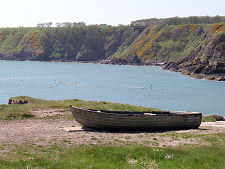 View South from Boddin Point | |
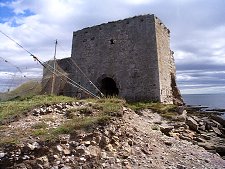 The Limekiln in 1996 | |
 ...and in 2003 |
The maps show a harbour here, and on the sheltered western side of the point a concrete slipway leads down to the shore. A few boats pulled up onto the neck of Boddin Point amid drying nets and lobster pots shows some continuing activity. The shoreline beyond the slipway and along the coast to the inlet of Black Jack are said to be a good hunting ground for agates.
Two words of warning: this would be a bad place to be caught by an incoming tide, and signs of fresh erosion suggest that standing too close to the base of the cliffs without a hard hat (or at all) might not be a good idea.
The most prominent feature on Boddin Point itself is the limekiln standing at its seaward end. This dates back to the 1700s. Parts of the kiln have been in a state of collapse for many years. A visit in 2003 showed that undercutting by the sea on that side of the headland was getting worse, and we were surprised to find it still standing in 2008. But it really isn't clear what is holding up much of the structure, and it may not be there for very much longer
A track leads round to the top of the limekiln. Here you get great views south along Lunan Bay and out to the Bell Rock Lighthouse, but while admiring them remember that the south side of the kiln really could end up in the sea at any moment.
To the north east of Boddin Point the coast continues round past the ruins of a salmon fishing station built in the 1800s. A little further on you find Elephant Rock, a natural coastal arch that has been shaped by the sea into a resemblance of an elephant.
Close by is a clifftop cemetery. Here you can find the grave of one George James Ramsay. Not a well known man: but one who, according to his gravestone, was born on 24 November 1859, nineteen years after his death on 17 December 1840.
Friday, 10 August 2012
Subscribe to:
Posts (Atom)



